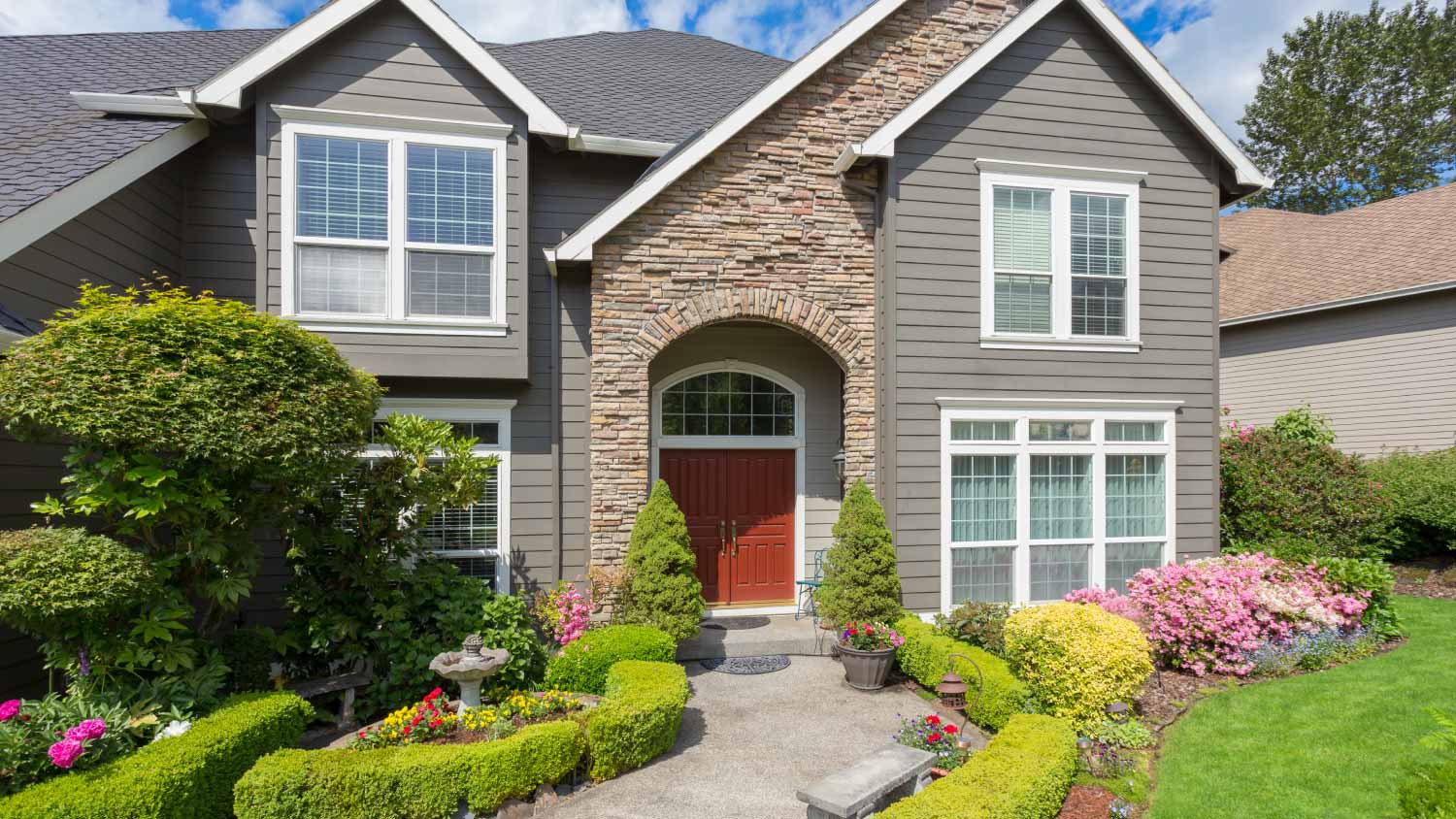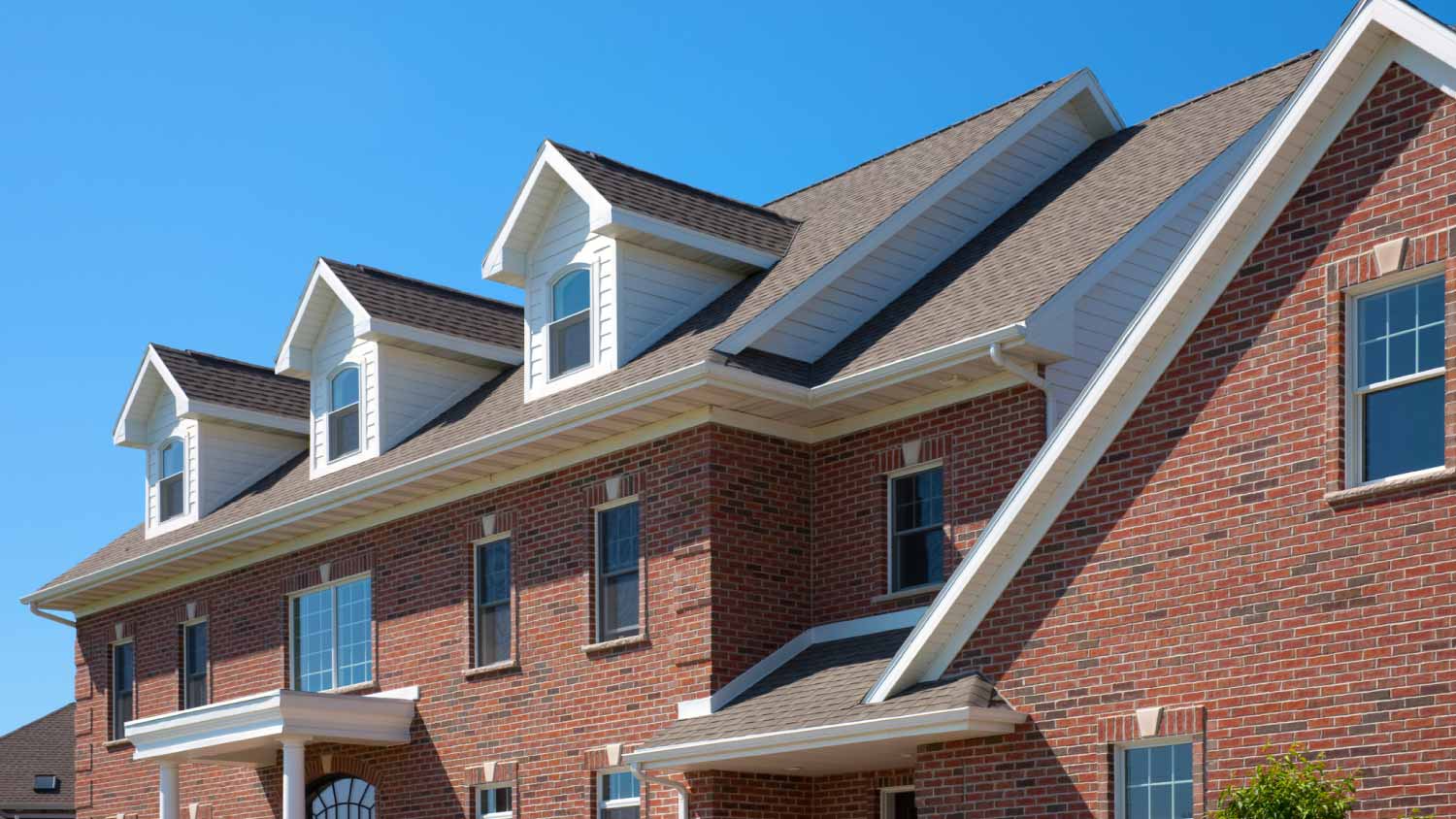
Cedar, pine, cypress, or fir—wood siding is a durable and elegant choice for the outside of your home. Here are the wood siding costs to expect.
Brick or stone siding: Which side will you take?


Both stone and brick are solid building materials, but you can also use them for siding to improve your home’s curb appeal.
Stone veneer is more expensive, but it’s also more durable and easier to maintain.
Brick veneer is more affordable than stone, and it’s a great insulator and waterproofer.
Both have unique looks—choosing between them ultimately comes down to your budget and aesthetic.
True brick and stone houses date back thousands of years and are known for their timeless aesthetic, durability, fire resistance, and low maintenance. Nowadays, you can enhance your home’s exterior look with stone and brick siding, which can also improve its energy efficiency, protect against water damage, and offer several other benefits.
But which one—stone vs. brick siding—is right for your home? Let’s compare the two materials to help you decide.
Stone and brick siding share a lot of similarities. Both brick and stone are long-lasting materials, and they’ve been used in construction for thousands of years. When used as siding, however, there are a few differences to keep in mind.
Brick siding is more affordable than stone siding, and it also acts as a better insulator and an additional layer of waterproofing. Stone siding is more expensive, but it’s also more durable and lower maintenance. When sourced naturally, stone siding is one of the greenest building materials you can use.

Stone siding, or stone veneer, refers to either natural or manufactured stone that serves as a covering for your home’s exterior, as an accent or over the entire surface. Unlike old stone houses that are entirely made of stone, stone siding simply serves as the exterior covering, but it is not structurally significant.
Natural stone siding uses real stone sourced from mountains, riverbeds, and quarries. Common stone siding types include basalt, granite, limestone, sandstone, and slate. These materials give your home a truly unique appearance, but they are also expensive. Faux stone and manufactured stone are entirely human-made but significantly lower the cost of installing stone veneer siding.
| Pros | Cons |
|---|---|
| Highly durable and fireproof | Expensive to source and install |
| Beautiful stone aesthetic | Difficult to install |
| Extremely low maintenance | Potential for moisture problems |
Best for:
Homeowners with a large siding budget
Homeowners who want low-budget siding
Homeowners who like the stone aesthetic
Natural stone siding is beautiful. Because it’s sourced from the earth, no two stones are the exact same size or look. This creates a truly unique aesthetic for your home’s exterior and can significantly boost its resale value. Manufactured and faux veneers aren’t as unique, but they still have mass curb appeal.
Stone veneer is also very low maintenance. It doesn’t require painting or frequent sealing, and it’s super easy to clean on your own. Stone is also naturally fire resistant, and the siding is durable, especially when using natural stone.
Stone siding is beautiful, but it’s also very expensive. Natural stone siding costs up to $35 per square foot for materials alone (with labor adding up to $15 per square foot, given how heavy stone can be). Installing manufactured stone veneer is more comparable to brick veneer, but it still tends to be more expensive.
Installation is difficult, so we always recommend hiring a pro to handle this task, even if it’s just an accent being adhered to a small part of your home’s exterior. (If you really want to tackle the task yourself, here’s how to install stone veneer in seven steps.) Even when expertly installed by a local mason, stone siding can be prone to moisture issues (and thus mold issues).
Note: A major pro of natural stone siding is that it’s a sustainable material in abundance, and it’s recyclable. However, many homeowners opt for cheaper manufactured stone, which is not at all environmentally friendly.

Solid brick masonry homes still exist today and are highly sought after, but if you’ve purchased a home that is not double brick or you are building a new home, your best bet for a brick aesthetic is brick veneer. Brick veneer is what we’re referring to when discussing brick siding.
So what’s the difference between brick and brick veneer? Brick veneer is a single wythe (layer) of brick adhered to the exterior of your home; brick veneer is largely for aesthetic and doesn’t offer the durability and fire and pest resistance of a solid brick masonry home. However, brick veneer is an affordable way to give your house some old-home charm, is highly energy efficient, and offers great insulation and waterproofing.
| Pros | Cons |
|---|---|
| More affordable than stone siding and solid brick walls | Less durable than stone siding and true brick walls |
| Great insulator and waterproofer | Requires more maintenance |
| Beautiful brick aesthetic | Doesn’t enhance home’s durability or fire resistance |
Best for:
Homeowners with a moderate siding budget
Homes that need better insulation
Homeowners who like the brick aesthetic
Brick siding is a great choice for homeowners who love the look of brick homes but have purchased a more modern home without solid brick walls. Brick veneer creates the look of brick walls without the major cost.
Brick veneer is also cheaper than stone veneer, particularly natural stone veneer. It’s highly energy efficient and a great insulator for your home, which can help with utility bills. Brick siding also serves as an extra layer of waterproofing for your home.
Brick siding does have some downsides to consider. Unlike solid brick masonry homes, brick veneer can’t be counted on for fire and pest resistance. Over time, brick veneer is susceptible to cracking and requires much more maintenance than stone siding.
So how do stone and brick siding stack up against one another?
Brick veneer costs significantly less than stone siding—about $13 per square foot, fully installed. Natural stone siding can cost upward of $44 per square foot, completely installed. Manufactured stone is cheaper to install, but brick veneer is still more affordable.
Note that neither siding type is considered budget-friendly. If you’re looking to save money on your siding project, consider vinyl siding. On average, vinyl siding costs between $2 and $10 per square foot.
Brick siding does not offer the same durability that true brick houses are known for. Because it’s only one width deep, brick siding is purely decorative and can be prone to cracking over time. Stone siding, on the other hand, is a highly durable material that serves as an extra layer of fireproofing for your home.
While stone siding can be prone to moisture problems (and eventually mold issues, if not properly monitored and managed), brick veneer actually serves as extra waterproofing for your home.
Both brick and stone can last a lifetime (or longer), but stone, in the end, will last longer as a siding than brick veneer. You could get 100 years or more out of natural stone siding. Note that manufactured stone veneer won’t last as long but could still go 50 to 75 years before serious issues occur.
While we always recommend finding a highly reviewed and licensed siding contractor near you for both brick veneer and stone veneer installs, brick veneer is easier to install as a DIY project. Here’s how to install brick veneer siding if you’re up for the task, but only attempt if you have prior siding and masonry experience.
Brick veneer requires a good deal of maintenance. You’ll regularly need to monitor and maintain the mortar between bricks, but you’ll also need to inspect and unclog weep holes, check the caulk joints, routinely clean the brick veneer, and replace crumbling bricks. Stone siding, on the other hand, is relatively easy to maintain; an occasional washing should do the job.
When it comes to aesthetics, there’s no true winner. Both brick and stone are timeless, and they can serve well as the comprehensive siding material for your home or as an accent with another type of siding. In fact, you can even mix brick and stone exteriors together for a unique, attractive look. Both brick and stone have mass curb appeal, so it really comes down to your preference.
Brick veneer costs significantly less than stone siding—about $13 per square foot, fully installed. Natural stone siding can cost upward of $44 per square foot, completely installed. Manufactured stone is cheaper to install, but brick veneer is still more affordable.
Note that neither siding type is considered budget-friendly. If you’re looking to save money on your siding project, consider vinyl siding. On average, vinyl siding costs between $2 and $10 per square foot.
Brick siding does not offer the same durability that true brick houses are known for. Because it’s only one width deep, brick siding is purely decorative and can be prone to cracking over time. Stone siding, on the other hand, is a highly durable material that serves as an extra layer of fireproofing for your home.
While stone siding can be prone to moisture problems (and eventually mold issues, if not properly monitored and managed), brick veneer actually serves as extra waterproofing for your home.
Both brick and stone can last a lifetime (or longer), but stone, in the end, will last longer as a siding than brick veneer. You could get 100 years or more out of natural stone siding. Note that manufactured stone veneer won’t last as long but could still go 50 to 75 years before serious issues occur.
While we always recommend finding a highly reviewed and licensed siding contractor near you for both brick veneer and stone veneer installs, brick veneer is easier to install as a DIY project. Here’s how to install brick veneer siding if you’re up for the task, but only attempt if you have prior siding and masonry experience.
Brick veneer requires a good deal of maintenance. You’ll regularly need to monitor and maintain the mortar between bricks, but you’ll also need to inspect and unclog weep holes, check the caulk joints, routinely clean the brick veneer, and replace crumbling bricks. Stone siding, on the other hand, is relatively easy to maintain; an occasional washing should do the job.
When it comes to aesthetics, there’s no true winner. Both brick and stone are timeless, and they can serve well as the comprehensive siding material for your home or as an accent with another type of siding. In fact, you can even mix brick and stone exteriors together for a unique, attractive look. Both brick and stone have mass curb appeal, so it really comes down to your preference.
From average costs to expert advice, get all the answers you need to get your job done.

Cedar, pine, cypress, or fir—wood siding is a durable and elegant choice for the outside of your home. Here are the wood siding costs to expect.

Brick veneer is a popular siding material that can boost your curb appeal. Learn all about how much this siding material costs based on factors like location and type.

Typical stone siding costs can surpass $100K, but the huge ROI potential may be worth the investment. Get the full cost breakdown of labor and materials here.

Not sure you want to go with the standard siding material for your home? Learn about vinyl siding pros and cons to see if there’s a better option.

Discover the pros, cons, and everything else you need to know about insulated vinyl siding.

Choosing the right siding can boost your curb appeal and protect your home. Our guide explores 12 siding options to help you decide.